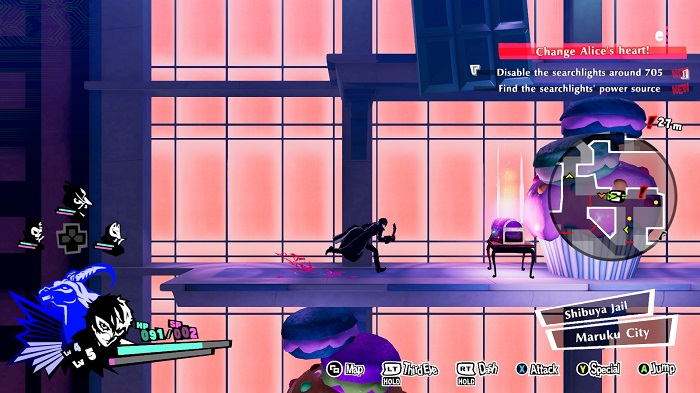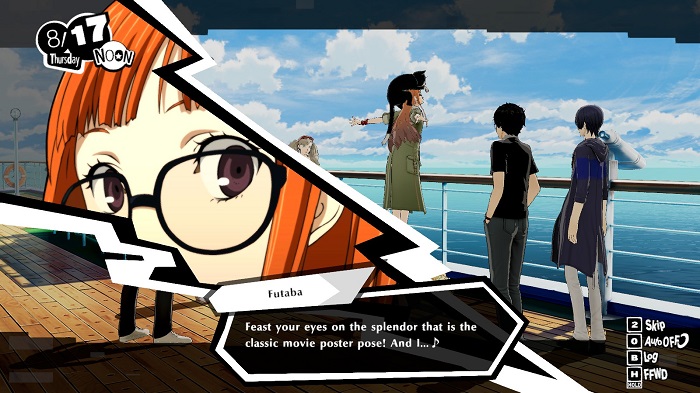Subjective:
Developer ATLUS and publisher SEGA present Persona 5: Strikers for review (Strikers for the rest of this piece). Strikers continues the story of the Phantom Thieves as they go on a road trip of virtue. The road trip coincides with their new investigation into cognitive prisons which draw in unsuspecting innocents to an egomaniacal figure of exploitation. By learning the ins and outs of their new targets, the Phantom Thieves may discover the identity of the new force of evil who preys on insecurity and selfishness.
Objective:
Strikers is a direct continuation of the story which began in Persona 5, initially released on PlayStation consoles. It adapts the turn-based combat of its predecessor to an action-RPG format. The player creates a team of four from the roster of Phantom Thieves and controls one at a time. While the player may switch freely between the active party members, there is a system of buffs which encourage exploiting enemy weaknesses and allows non-active party members to switch in for empowered hits. Between fights the player navigates around crafted dungeons and utilizes environmental traps to attack or pounce on unsuspecting foes.

Assessment:
I was worried that Strikers, which adapts one of my favorite RPGs of all-time to a new combat system, wouldn’t make the transition effectively. For the most part, I was right. Strikers is an often awkward fit for the flashy – if deliberate – pacing that was established in Persona 5. The new combat system is primarily to blame, and it takes a long time to get used to.
In Persona 5, the complex series of weaknesses, counters, buffs, technical hits, baton passing, and so on each coincided with a plot development. That pacing of plot development introduced each new combat mechanic at a measured pace.
Strikers‘ first, and to a lesser extent second, dungeons are a mess of tutorials. Each status ailment pauses the action, characters interrupt dungeon exploration to highlight a new buff or environmental item to use, enemies and allies alike constantly speak in combat and kill the flow of action. Considering the majority of status ailments translate to, “Rotate stick until clear,” and buffs simply make numbers larger, the mess of words and interruptions makes a digital avalanche of information when a light flurry would do.
This similarly makes the pop art styling of Strikers sometimes a frustrating slog to make sense of. Each splash of color that erupts from a single attack is one of sometimes dozens that overwhelm the field. This leads to a cluttered mess of distracting visual information when I needed to keep track of who is casting what, who needs a buff, and so on. Unfortunately, it’s currently impossible to tone down the overall amount of visual overload since it’s baked into the core style of Strikers.

Bless the talent of composers Atsushi Kitajoh, Gota Masuoka, and Ayana Hira for providing me a musical through-line. Their compositions are, thankfully, less fluid than the turn-based predecessor. The stronger rhythm section and greater emphasis on drums gave the battles a percussive direction that otherwise became lost in the visuals. In some moments I caught myself humming along the action synced to the beat and the actions of the Phantom Thieves. These moments felt and made sense as a sort of music video, which also befits their new status as national celebrities.
Strikers clicked together at this point. I didn’t love it, but the beats and slowly fading tutorials tightened up the rest of the experience. As Strikers calmed down, the system of buffs et. al. became easier to follow. So combat that went beyond a few seconds (as ambushes tended to end quickly) finally engaged on a level approaching, but never reaching, the original Persona 5.
It helps that the Phantom Thieves are also given the opportunity to settle into their more confident selves. In this case, that means shining as absolute lovable dorks. There are tiny moments, like Mona playing knight to candies for Ann, and large, like Futaba’s wildly fluctuating confidence inspiring misremembered classic film recreation. These moments tie together an experience that fulfills its promise of character interaction and tight gameplay continuously as the burdens of tutorials finally fall away.

Persona 5: Strikers was played and reviewed using a reviewer-purchased copy of the PC version on the Steam platform.
The Review
Persona 5: Strikers
None of this is going to matter if you didn't already love Persona 5. There's too much jank and junk in the way as the series transitioned from turn-based to action. I can't, in good conscience, tell anyone to stick through the bad to get to the good. But since I did I must report as such. Strikers got good, but sweet gravy did it take its time getting there.
PROS
- Composers Atsushi Kitajoh, Gota Masuoka, and Ayana Hira modulate their music perfectly from the original, giving Strikers a line through the visual noise.
- The personalities of the Phantom Thieves collide in breezy entertainment.
CONS
- Far too much redundant tutorializing that emphasizes the same actions and reactions.
- The explosive pop art colors which worked well in a turn-based environment take too long to calm the heck down into a cohesive approach for Strikers.



